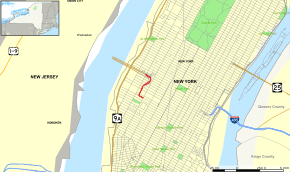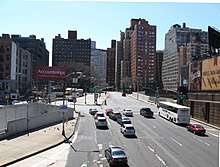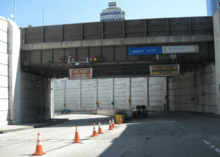Lincoln Tunnel Expressway
The Lincoln Tunnel Expressway is an eight block-long, mostly four-lane, north–south arterial road between the portals of the Lincoln Tunnel and West 30th Street in Midtown Manhattan in New York City. Dyer Avenue is an at-grade roadway paralleling part of the mostly depressed roadway and serves traffic entering and leaving the expressway and the tubes of the tunnel. Like the tunnel, the roads are owned and operated by the Port Authority of New York and New Jersey.[2] They traverse the Manhattan neighborhoods of Hell's Kitchen and Chelsea between Ninth and Tenth avenues.[3]
| Lincoln Tunnel Expressway | |
|---|---|
 Map highlighting Lincoln Tunnel Expressway and extension onto West 30th Street | |
| Route information | |
| Length | 0.8 mi[1] (1.3 km) |
| Component highways | |
| Major junctions | |
| South end | West 30th Street in Hudson Yards |
| North end | Lincoln Tunnel (NY 495) in Hell's Kitchen |
| Highway system | |
Route
The Lincoln Tunnel Expressway runs eight blocks and runs within the Manhattan neighborhoods of Hell's Kitchen and Chelsea, between Ninth Avenue to the east and Tenth Avenue to the west, connecting to the Lincoln Tunnel to New Jersey at its northern end. The southern terminus of the expressway is located at West 30th Street, midblock between Ninth and Tenth Avenues. The block of 30th Street between these two avenues is a six-lane divided street: the southern roadway hosts eastbound local traffic, while the northern roadway funnels northbound traffic from Tenth Avenue east into the northbound expressway, and southbound traffic from Ninth Avenue west into the expressway. Southbound expressway traffic is forced to turn left onto eastbound 30th Street.[4][5]
The expressway then continues north as Dyer Avenue, a divided four-lane street, for one block. At 31st Street, there is a traffic light, and the expressway continues north underneath the Manhattan West development and local streets as a grade-separated highway. The highway passes under 33rd Street, where an entrance and exit ramp to and from the Lincoln Tunnel descends from 33rd Street to the median of the below-grade highway, merging with the respective directions of traffic. The Lincoln Tunnel Expressway passes under local streets for three more blocks. At 36th Streets ramps lead to and from the southbound highway, while a ramp from northbound Dyer Avenue and southbound Ninth Avenue merges into the northbound highway.[4][5]
The Lincoln Tunnel Expressway passes under 37th Street and then curves west. The northbound roadway splits into two ramps: one leading to the normally-bidirectional center tube, the other leading to a short tunnel that connects to the westbound-only northern tube. The bidirectional roadway can be closed to either direction of traffic if the center tube is operating in one direction, although southbound expressway traffic would be completely cut off when the center tube operates westbound to New Jersey. The expressway dips under a ramp to northbound Dyre Avenue, which splits from both the eastbound-only southern tube and the eastbound lane of the center tube just west of this overpass. A ramp from the Port Authority Bus Terminal merges with the westbound highway at this point. The expressway then connects to the western tube of the tunnel just east of Tenth Avenue.[4][5]
History

Need

In 1934, a number of buildings in the neighborhood were demolished to construct the 75-foot-wide (23 m) right-of-way of Dyer Avenue, an arterial street providing access to the then-under-construction Lincoln Tunnel.[6] Dyer Avenue was named after General George Rathborne Dyer, who was the chairman of the board of the Port Authority and died while the tunnel was under construction.[7][8] The tunnel's first (now center) tube opened in December 1937.[9][10] A second tube opened to the north in 1945,[11] but the tunnels only had a combined capacity of 15 million vehicles per year, and by 1949, the tubes were already carrying 11 million annual vehicles.[12]
In March 1951, the Port Authority commissioners gave their approval to preliminary plans for a third tube of the Lincoln Tunnel, to the south of the two existing tubes. The project would also involve extending the Dyer Avenue approach, on the Manhattan side, southward from 34th Street to 30th Street. It included the approach roads in Manhattan and Hudson County, New Jersey, as outlined in the Joint Study of Arterial Facilities which had been commissioned by the agency and the Triborough Bridge Authority.[8] The tube was completed in May 1957 at a cost of $85 million.[13]
Construction
The Lincoln Tunnel Expressway was first conceived during the planning process for the tunnel's third tube. The city of New York had had concerns that existing streets could not adequately handle the extra traffic from the third tube.[14] After fifteen months of negotiation, the city and the Port Authority came to an agreement in June 1952.[15] The agency agreed to widen 30th Street between 10th Avenue and 12th Avenue, and to provide ramps between the tunnel and the West Side Highway. This included the construction of the Lincoln Tunnel Expressway between 30th Street and the tunnel entrance at 38th Street.[16]
The expressway was opened on February 19, 1957, just before the opening of the third tube, at a cost of $11 million.[17] At the highway's opening, it was described as a "triumph of engineering skill". The New York Times stated, "In constructing the approach highway, engineers had to build a bridge under an existing bridge, provide two twin tunnels and five viaducts, depress the roadbed in part, elevate it at other places, and develop an intricate network of entrance and exit ramps at intermediate points."[5] As part of the expressway design, ramps were constructed to the Port Authority Bus Terminal.[18][19] Pamphlets were issued to motorists at the expressway's opening.[5]
Mid-Manhattan Expressway and I-495 designation
The Lincoln Tunnel Expressway is designated the unsigned NY 495.[20] The expressway was to be integrated into the unbuilt Mid-Manhattan Expressway, a crosstown route leading to the Queens-Midtown Tunnel, now part of Interstate 495, and be designated I-495.[21] The I-495 designation was assigned to the New Jersey approach to the tunnel in 1958[21] in anticipation of the Mid-Manhattan Expressway being completed. That crosstown project was later canceled and was officially removed from I-495 on January 1, 1970.[22] The New Jersey stretch of I-495 became New Jersey Route 495 in 1979.[23] The I-495 designation was removed from the Lincoln Tunnel In 1989.
Open space and air rights
The area around the Lincoln Tunnel Expressway-Dyer Avenue corridor has been rezoned for commercial and residential development as part of the Hudson Yards Redevelopment Project and the construction of the 7 Subway Extension. The 2003 the New York City Department of City Planning issued a master plan that calls for the creation of a network of open space between Ninth Avenue and Tenth Avenue to create a park system from West 39th Street to West 34th Street.[24][2][3]
As of 2014, the PANYNJ owned about 19 acres (7.7 ha) of property in Midtown West, mostly between 30th and 41st streets and 9th and 10th avenues, much it dedicated to transportation. [25] In addition to owning the roadways the PANYNJ also owns adjacent parcels along the right-of-way and is actively attempting to divest itself of the property acquired during original construction or for development of the canceled ARC Tunnel. Funds would be used for the redevelopment of the Port Authority Bus Terminal and other infrastructure improvements.[26][27][28]
In 2011, the city approved construction of two 18 stories building at 9th Avenue between 37th and 38th streets.[29] In April 2012, the PANYNJ reported that a proposal had been made by developer Larry Silverstein, who has a memorandum of understanding to develop this property at 39th Street to construct a bus garage with a residential tower above it.[30][31] The parcel is not large enough to accommodate bus ramps and would require the use of elevators, a new type of application for bus storage.[32] In September 2014, Extell Development Company purchased air rights for $30 million for a parcel between 36-37th streets. A platform or a cantilever structure over the expressway could be built.[33][34] While approved by the PANYNJ the sale of parcels at 30th Street to the McDermont Company for a 500,000-square-foot residential tower the plans were dropped.[35][36] and the land was put back on the market.[37]
Exit list
The entire route is in the New York City borough of Manhattan. All exits are unnumbered.
| Location | mi[1][38] | km | Destinations | Notes | |
|---|---|---|---|---|---|
| Hudson Yards | 0.00 | 0.00 | West 30th Street east to Ninth Avenue south | At-grade intersection | |
| 0.02 | 0.032 | West 31st Street | At-grade intersection | ||
| 0.2 | 0.32 | West 33rd Street west | Eastbound exit and westbound entrance | ||
| Hell's Kitchen | 0.3 | 0.48 | Eastbound exit and westbound entrance via Dyer Avenue south | ||
| 0.4 | 0.64 | Ninth Avenue | Westbound entrance only | ||
| 0.5 | 0.80 | Eastbound exit and westbound entrance via Dyer Avenue north | |||
| 0.6 | 0.97 | West 39th Street | Exit and entrance from the North Tube | ||
| 0.7 | 1.1 | West 40th Street / Galvin Avenue – Port Authority Bus Terminal | Westbound entrance to the North Tube | ||
| 0.8 | 1.3 | Lincoln Tunnel west (Route 495) – New Jersey | Continuation west | ||
| 1.000 mi = 1.609 km; 1.000 km = 0.621 mi | |||||
See also
- Trans-Manhattan Expressway
- Holland Tunnel Rotary
References
- Google (September 8, 2015). "Lincoln Tunnel Expressway" (Map). Google Maps. Google. Retrieved September 8, 2015.
- "No. 7 Subway Extension—Hudson Yards Rezoning and Development Program FGEIS" (PDF). www.nyc.gov. Archived from the original (PDF) on October 25, 2012. Retrieved February 20, 2015.
- "Hudson Yards The Area". Department of Planning City of New York. Archived from the original on February 20, 2015. Retrieved February 16, 2015.
- Google (December 22, 2016). "Lincoln Tunnel" (Map). Google Maps. Google. Retrieved December 22, 2016.
- Ingraham, Joseph C. (February 19, 1957). "Tube Connection Will Open Today". The New York Times. ISSN 0362-4331. Retrieved April 8, 2018.
- "Part of Hell's Kitchen Doomed by Tunnel; 91 Houses to Be Razed to Build Approach". The New York Times. August 27, 1934. ISSN 0362-4331. Retrieved March 24, 2018.
- Moscow, Henry (1990). The Street Book: An Encyclopedia of Manhattan's Street Names and Their Origins. New York: Fordham University Press. p. 46. ISBN 0-8232-1275-0.
- Ingraham, Joseph C. (March 9, 1951). "Third Lincoln Tube Voted by Port Unit". The New York Times. ISSN 0362-4331. Retrieved April 4, 2018.
- Whyte, William H. (1995) [1939]. The WPA Guide to New York City: The Federal Writers' Project Guide to 1930s New York. New York: New Press. p. 156. ISBN 1-56584-321-5.
- "Lincoln Tunnel Is Opened with Festive Ceremonies". The New York Times. December 22, 1937. ISSN 0362-4331. Retrieved March 26, 2018.
- "New Lincoln Tube Will Open Today". The New York Times. February 1, 1945. ISSN 0362-4331. Retrieved March 29, 2018.
- "Driscoll Suggests a 3d Hudson Tunnel". The New York Times. August 10, 1949. ISSN 0362-4331. Retrieved April 4, 2018.
- Ingraham, Joseph C. (May 26, 1957). "3d Lincoln Tube Is Opened". The New York Times. p. 1. Retrieved February 27, 2010.
- "Lincoln Tube Plan Due for Rejection". The New York Times. August 8, 1951. ISSN 0362-4331. Retrieved April 5, 2018.
- "A $90,000,000 Tunnel". The New York Times. June 4, 1952. ISSN 0362-4331. Retrieved April 5, 2018.
- Ingraham, Joseph C. (June 4, 1952). "City and Port Body Make Compromise on 3d Lincoln Tube". The New York Times. ISSN 0362-4331. Retrieved April 5, 2018.
- "Tube Express Way Opens to Traffic". The New York Times. February 20, 1957. ISSN 0362-4331. Retrieved April 8, 2018.
- Robert W., Jackson (2011). Highway Under the Hudson: A History of the Holland Tunnel. NYU Press. ISBN 9780814745038.
- Flint, Anthony (2009). Wrestling with Moses: How Jane Jacobs Took On New York's Master Builder and Transformed the American City. Random House. p. 143.
- Google (February 16, 2015). "495" (Map). Google Maps. Google. Retrieved February 16, 2015.
- Gillespie, Angus K (2011). Crossing Under the Hudson: The Story of the Holland and Lincoln Tunnels. Rutgers University Press.
- State of New York Department of Transportation (January 1, 1970). Official Description of Touring Routes in New York State (PDF). Retrieved June 25, 2010.
- "Route 495 Straight Line Diagram" (PDF). New Jersey Department of Transportation. 2006. Archived from the original (PDF) on March 21, 2006. Retrieved September 13, 2014.
- "Hudson Yards Master Plan: Preferred Direction" (PDF). New York City Department of City Planning. February 2003. Archived from the original (PDF) on December 14, 2011. Retrieved February 15, 2015. Cite journal requires
|journal=(help) - "Midtown Properties". Port Authority of New York and New Jersey. Retrieved February 22, 2015.
- "Lincoln Tunnel Expressway: Sale of Land and Development Rights" (PDF). Port Authority of New York and New Jersey. June 25, 2014. Retrieved February 20, 2015.
- "Minutes" (PDF). Port Authority of New York and New Jersey. September 17, 2014. Retrieved February 20, 2015.
- Morris, Keiko (March 7, 2014). "Port Authority Land for Sale Amid Rising Prices, Agency Puts Two Parcels on Market". The Wall Street Journal. Retrieved February 20, 2015.
- http://www.nyc.gov/html/mancb4/downloads/pdf/Resolutions/July%202011/04%20EXEC%20Letter%20to%20DCP%20re%20Hudson%20Mews%20renewal%20application%20-%20Final%20Version.pdf
- Chaban, Matt (April 26, 2012). "Silverstein Beats Vornado to the Port Authority Punch Again, Proposes New Bus Terminal on West 39th Street". The New York Observer. Retrieved May 28, 2012.
- Smerd, Jeremy (April 25, 2012). "'Provocative' proposal made for new bus garage". Crain's New York Business. Retrieved May 28, 2012.
- Rubenstein, Dana (May 1, 2012). "Can special elevators spare Manhattan-bound buses that pointless trips back to New Jersey?". Capital New York. Retrieved May 28, 2012.
- Bockmann, Rich (September 16, 2014). "Extell makes play for Port Authority's Hudson Yard air rights". The Real Deal. Retrieved February 20, 2015.
- "Port Authority Board Approves Sale of Dyer Avenue Development Rights" (Press release). Port Authority of New York and New Jersey. September 17, 2014. Retrieved February 20, 2015.
- Bockman, Rich (July 16, 2014). "Dermot to put up resi tower on Hudson Yards site Firm snagged property with $115M bid in Port Authority auction". The Real Deal. Retrieved February 20, 2014.
- Geiger, Daniel (October 31, 2014). "Port Authority loses $175M Hudson Yards tower deal". Crain's New York. Retrieved February 20, 2015.
- Sainger, Tobias (December 2, 2014). "Port Authority Puts Hudson Yards Parcels Back on Market". Commercial Observer. Retrieved February 22, 2015.
- "New York County Inventory Listing" (CSV). New York State Department of Transportation. August 7, 2015. Retrieved September 5, 2017.
External links
- "Lincoln Tunnel Expressway". Open Street Map. Retrieved February 10, 2015.
- "Lincoln Tunnel Expressway". Wikimapia. Retrieved February 10, 2015.
- "Lincoln Tunnel Expressway". Flickr. Retrieved February 10, 2015.